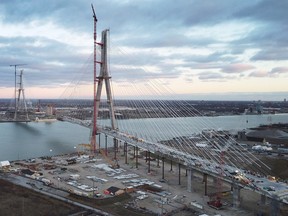
Article content
Thirty-six buildings, 297 acres, 5,000 km of cable strands.
When construction of the Gordie Howe International Bridge is finished by the fall of 2025, it will be the longest cable-stayed bridge in North America.
Article content
But the Gordie’s 853-metre main span is just one of its notable big numbers.
“These are the biggest land ports of entry between Canada and the U.S.,” said Charl van Niekerk, CEO of the Windsor-Detroit Bridge Authority. “I think the only other biggest one in North America is the one between U.S. and Mexico.”
Advertisement 2
Article content
Construction on the long-awaited bridge began in 2018 with a price tag of $5.7 billion. Up until two months ago, the targeted finish date was set for November 2024, but then came the announcement in January that both the cost and the opening date were being pushed back due to multiple issues including those brought on by a global pandemic.
The cost has climbed to $6.4 billion with a finish date now set for Sept. 2025.
The next major milestone is expected this summer with connection of the Canadian and U.S. sides of the bridge deck, which will meet 46 metres above the Detroit River to accommodate shipping lanes. The bridge is 2.5 km long with an 853-metre span over the water.
There are 216 stay cables — 108 on each side. For every 15-metre segment between the stay cables, the deck weighs about 300 tonnes.
Each stay cable will have between 38 and 122 rope-like metal strands. Laid end to end, those strands would stretch about 5,000 kilometres — a distance from Windsor almost to Alaska.
The cables connect the deck to the 220-metre towers, which are meant to reflect the curvature of a hockey stick mid-slapshot. The tower on the Canadian side, which reached its full height in December, is the tallest structure in Windsor.
Advertisement 3
Article content
Each tower leg is supported by six shafts drilled 36 metres into the bedrock, the equivalent of about an 11-storey building.

The skyline-changing bridge will have three lanes going in each direction, along with an extra one for emergencies, and the built-in ability to add another two lanes.
WDBA said many of the structures, such as inspection lanes, canopies, and toll booths, are now in advanced stages of construction. Crews have started installing carpet in some of the rooms.
The Canadian port of entry site is about 130 acres with 11 structures, 16 toll lanes, and 24 primary inspection lanes.
The U.S. side is about 167 acres with 13 structures and 36 primary inspection lanes.

“We’ve got on-site full-scale imaging,” said van Niekerk. “So it will reduce the time trucks need to go through secondary processing. The border agency can inspect the vehicles in an air-conditioned facility, but the need for that will be reduced with on-site imaging technology we have on both sides of the border.”
The new international bridge, which will also have a multi-use path for pedestrians and cyclists, will be the first to join the Trans Canada Trail. There will also be a dedicated border processing facility for pedestrians and cyclists separate from the areas for vehicles.
Advertisement 4
Article content
“Pedestrians and cyclists will be able to cross free,” said van Niekerk.
Recommended from Editorial
The cost of crossing for vehicles is one of the few numbers that hasn’t been hammered down. Van Niekerk said the tolls will not be determined until early next year.
“We’re busy doing a study of who is our market,” he said. “Of course, comparing ourselves to other crossings in the region so we set a reasonable rate. And then working with government to set the toll rate policy.”
Article content





